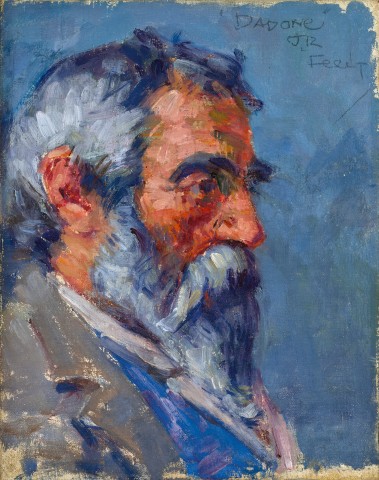DADONE, c.1900
JOHN PETER RUSSELL
oil on canvas
32.0 x 25.5 cm
signed with initials and inscribed with title upper right: Dadone / J.R / FeciT
The artist
Thence by descent
Jeanne Jouve, the artist’s eldest child and only daughter
Private collection, a gift from the above in 1948
Private collection, Paris, purchased in 2000
Sotheby’s, Melbourne, 19 September 2005, lot 10
The Reg Grundy AC OBE and Joy Chambers-Grundy Collection (label attached verso)
Important Australian Art from the Collection of Red Grundy AC OBE and Joy Chambers-Grundy, Bonhams, Sydney, 26 June 2013, lot 72
Private collection, Melbourne
John Peter Russell holds a unique place in Australian art history for his close association with avant-garde circles in 1880s Paris and his firsthand acquaintance with masters of European Impressionism and Post-Impressionism. As a student at Fernand Cormon’s atelier in Paris in the mid-1880s, Russell worked alongside Émile Bernard, Henri de Toulouse-Lautrec and later, Vincent van Gogh, with whom he established an enduring friendship.1 On a summer break from Paris in 1886, Russell spent several months on Belle-Île, one of a group of small islands off the coast of Brittany. It was here that he met and befriended Claude Monet who he saw working
en plein air, famously introducing himself by asking if Monet was indeed ‘the Prince of the Impressionists’. Inevitably flattered, Monet, who was eighteen years Russell’s senior, took a liking to the young Australian and dined with him and his beautiful wife-to-be, enjoying their hospitality and company during his stay on the island. Uncharacteristically, Monet also allowed Russell to watch him work and on occasion, to paint alongside him, experiences that provided an extraordinary insight into the techniques and working method of one of the founders of the Impressionist movement. The influence on Russell was significant and the paintings he made in Italy and Sicily only a few months later show him working in a new style, creating compositions that are made up of strokes of pure high-keyed colour.2
Captivated by the rugged beauty of Belle-Île and attuned to the possibilities the environment presented for the development of his art, Russell – whose inherited wealth meant he didn’t have to find paid employment – bought land overlooking the inlet of Goulphar in 1887. Writing to Tom Roberts, he said, ‘I am about to build a house in France. Settle down for some five years. Get some work done. It will be in some out of the way corner as much as a desert as possible.’3 Living there permanently until 1909, Russell developed an intimate knowledge of the island’s geography, both from the land and the sea, and this informed many of his best known paintings such as Port-Goulphar, Belle-Île, 1887 (Art Gallery of New South Wales) and Rough Sea, Belle-Île,
1900 (National Gallery of Victoria), which capture the distinctive light, changing colours and atmospheric conditions of his island home.
Russell was also a talented painter of portraits and just as his images of the Belle-Île landscape describe areas he knew intimately, so too, the subjects of his portraits are typically people with whom he had a close relationship. His great friend, van Gogh, is the subject of a fine 1886 portrait which is in the collection of the Van Gogh Museum in Amsterdam. Russell’s wife, Marianna – an Italian beauty who had modelled for the sculptor, Rodin – was the subject of numerous works. Her mother also sat for Russell and this intimately-scaled profile portrait depicts her father, Pasquale Mattioco – the colloquial Italian term ‘Dadone’ acknowledging his status as a senior male relative. The artist’s respect for his subject is clear and, as well as rendering the subject’s physical appearance, the portrait speaks to the wisdom and experience of a long life. With an emphasis on shades of blue, with white and grey highlights, the painting recalls Russell’s seascapes, and the image is built up in a series of energetic and assured brush strokes which reflect what Russell scholar, Ann Galbally, described as the artist’s distinctive ‘intensity of vision.’4
1. Although Russell did not see van Gogh again after he departed for Arles in the south of France in early 1888, their friendship continued via an extensive correspondence. See Galbally, A.,
A Remarkable Friendship: Vincent van Gogh and John Peter Russell
, The Miegunyah Press, Carlton, 2008
2. Taylor, E., ‘John Russell and friends: Roberts, Monet, van Gogh, Matisse, Rodin’, Australian Impressionists in France, National Gallery of Victoria, Melbourne, 2013, p. 60
3. Russell to Tom Roberts, 5 October 1887 quoted in Tunnicliffe, W., (ed.), John Russell: Australia’s French Impressionist, Art Gallery of New South Wales, Sydney, 2018, p. 193
4. Galbally, op. cit., p. 15
KIRSTY GRANT
